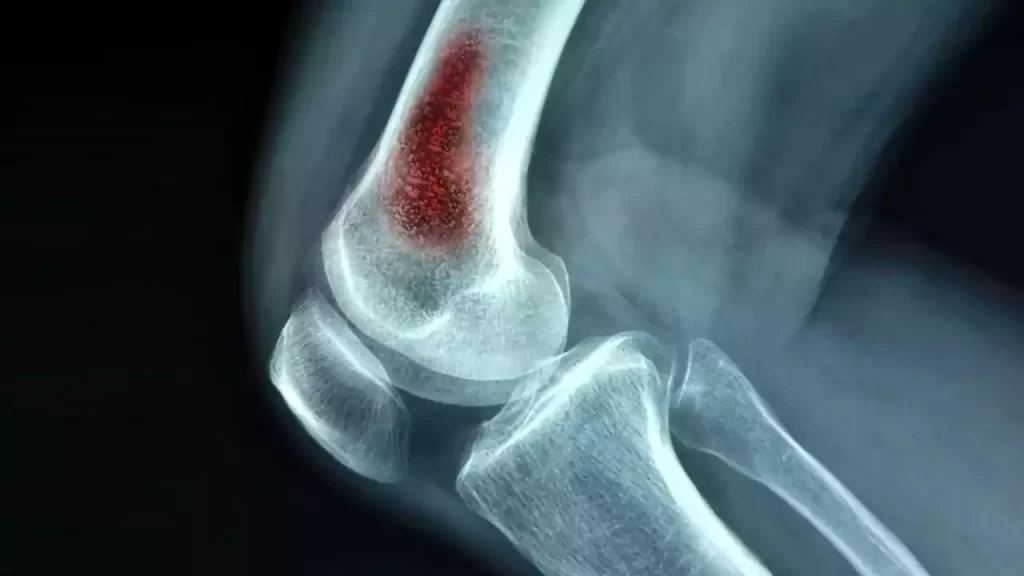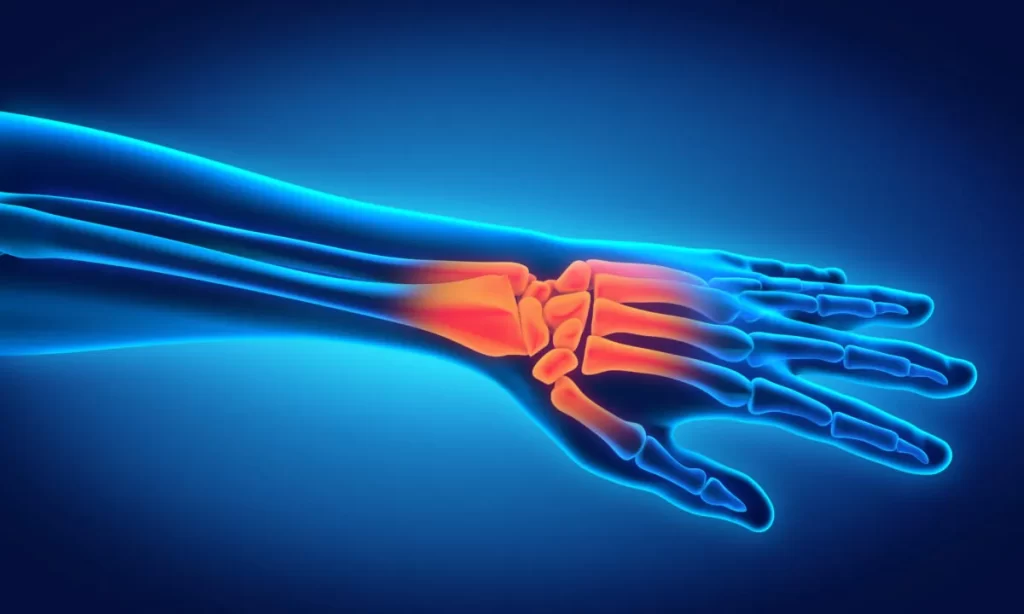Osteomyelitis and Osteomalacia affect bone health but differ in their nature. Osteomyelitis is a bone infection, while Osteomalacia is a bone-softening condition due to vitamin D deficiency.
Osteomyelitis can be a severe bone infection, usually caused by bacteria, which leads to inflammation and bone loss. It can occur after an injury or surgery and cause symptoms such as discomfort, fever, and swelling.
Doctors identify it by scans and tests in the lab and deal with it using antibiotics, and occasionally surgical procedures to eliminate infected bone. Osteomalacia is an ailment in which bones are soft because of a deficiency in vitamin D or difficulties in absorption.
This causes bones to become weaker and more prone to breaking. Patients with osteomalacia may be afflicted by muscle weakness, pain in the bones, and fractures. Treatment is based on calcium and vitamin D supplements, in addition to exposure to sunlight and changes in diet to build bones.
What is Osteomyelitis?
Osteomyelitis is a severe infection that affects the bones. It is usually caused by bacteria or germs being introduced into the bone via the process of surgery, injury, or through the bloodstream. The infection can cause pain, swelling, and redness in the area affected.

Sometimes, it may lead to the formation of pus in the bone. Patients suffering from osteomyelitis may feel sick or feel chilly. Doctors diagnose it by scans of the X-rays, MRI scans, or blood tests.
Treatment includes powerful antibiotics to destroy the bacteria that cause the infection. In the case of severe instances, surgery might be required to remove the bone that is damaged or to drain pus.
If not treated appropriately osteomyelitis may cause fractures in the bone as well as spread to various areas in the body which can cause additional complications.
What is Osteomalacia?
Osteomalacia is an illness in which bones are weak and soft because of a deficiency in vitamin D or difficulties in taking it in. Vitamin D assists the body in making use of calcium and phosphorus to build strong bones.

If a person doesn’t have sufficient Vitamin D in their diet, the bones don’t strengthen properly. This makes bones brittle and more prone to break or bend which can cause pain and fractures even in the case of minor bumps or falls.
Patients with osteomalacia may suffer from bone pain, muscle weakness, and trouble getting around. Treatment includes taking calcium and vitamin D supplements, in addition to spending hours in sunlight as sunlight aids in the production of vitamin D.
Making adjustments to your diet to include foods that are rich in calcium and vitamin D can help in strengthening bones.
Symptoms and Causes of Osteomyelitis
Symptoms of Osteomyelitis:
Localized Symptoms:
- Pain that persists or gets worse on the affected part of the bone.
- Tenderness, swelling, and warmth over the area of infection.
- Inflammation or redness over the skin lining the bone.
- The restriction of movement is a problem or you have difficulty in using the joint or limb affected.
Systemic Symptoms:
- Chills and fever.
- Inflammation or fatigue.
- General malaise or feeling unwell.
Causes of Osteomyelitis:
- Bacterial Infection: Most often results from Staphylococcus aureus, but other bacteria such as Streptococcus or Escherichia Coli can be responsible as well.
- Direct Entry of Bacteria: Injury or trauma that exposes bones to bacteria (fractures and open wounds surgical procedures)
- Spread of Infection: Infections cause bacteria that reach the bone via the bloodstream that is derived from other regions of the body.
- Chronic Health Conditions: Diabetes, peripheral vascular diseases, or weak immune systems that make them more susceptible to infections
- Medical Interventions: Injection of devices for medical use, such as plates or prosthetic joints for bone repair surgery that can serve as entrance points for bacteria.
Symptoms and Causes of Osteomalacia
Symptoms of Osteomalacia:
- Bone Pain: The pain is dull and aching on the joints, mainly in the lower back, hips legs, ribs, and hips.
- Muscle Weakness: A decrease in muscle strength and an increase in fatigue, causing difficulties when moving.
- Fractures: The risk of fractures increases because of weak bones, even in the case of minor stress or trauma.
- Difficulty Walking: A slowed gait or trouble walking due to bone pain or muscle weakness.
- Deformities: Rarely, bone deformities can occur such as bowing legs, or any other bone anomalies can be seen in extreme instances.
Causes of Osteomalacia:
- Vitamin D Deficiency: A lack of adequate intake of vitamin D from diet or not enough exposure to sunlight, reducing the body’s ability to create sufficient vitamin D.
- Malabsorption Issues: Conditions that hinder the absorption of minerals and vitamin D, such as celiac diseases or inflammatory bowel disorders, as well as surgical removals of certain parts of the intestinal.
- Kidney Disorders: Kidney disorders or specific drugs that affect the conversion of vitamin D into its active form, which is essential to maintaining bone health.
- Liver Disorders: Liver disorders that hinder the creation of an enzyme essential to activating vitamin D within the body.
- Dietary Deficiencies: Insufficient dietary sources of calcium or vitamin D are important to bone health.
Treatment Options for Osteomyelitis and Osteomalacia
Treatment Options for Osteomyelitis:
- Antibiotics: Antibiotic therapy is the most common therapy for osteomyelitis. An antibiotic regimen is typically administered intravenously to target the particular bacteria responsible for the infection.
- Surgical Interventions: The need for surgery may be needed to relieve abscesses, remove the infected bone or tissue fragments, or deliver antibiotics directly to the site of infection.
- Long-term Antibiotic Therapy: In severe or chronic cases the long-term use of oral antibiotics may be required to eliminate the infection.
- Pain Management: Treatments and medications for discomfort and pain associated with the ailment and treatment.
Treatment Options for Osteomalacia:
- Vitamin D and Calcium Supplementation: Vitamin D supplementation as well as calcium are the main therapy for osteomalacia. This aids in getting back to regular bone mineralization.
- Sunlight Exposure: Exposure to sunlight in a safe manner helps the skin make vitamin D naturally helping in the treatment of osteomalacia.
- Dietary Changes: Increased intake of foods that are rich in vitamin D (fatty fish dairy products, fortified dairy products), as well as calcium (dairy and leafy greens), can help support the health of bones.
- Medical Follow-up and Monitoring: Regularly scheduled check-ups and monitoring of vitamin D levels in order to alter the dosage of supplements and ensure that the bone is healing properly.
- Physical Therapy: Physical therapy and rehabilitation can increase muscle strength and mobility Particularly if there are fractures or bone weakness.
Risk Factors of Osteomyelitis and Osteomalacia
Risk Factors for Osteomyelitis:
- Injury or Trauma: Deep wounds or open fractures expose the bone to bacteria raising the chance of developing osteomyelitis.
- Recent Surgery: Surgery, particularly those that involve joint replacements or bones may introduce bacterial contamination into the bone, thereby increasing the risk.
- Compromised Immune System: Conditions like diabetes, HIV/AIDS cancer, HIV/AIDS, or other auto-immune diseases weaken the body’s ability to fight infection which makes people more susceptible to osteomyelitis.
- Circulatory Issues: A lack of blood circulation, which is commonly observed in peripheral vascular disease could hinder the transfer of antibiotics and immune cells to affected bone.
- Presence of Medical Devices: Prosthetic joints, implants, or screws utilized in bone surgery can act as potential places for bacterial colonization, thereby increasing the chance of contracting an infection.
Risk Factors for Osteomalacia:
- Vitamin D Deficiency: Lack of exposure to sun, deficiency of foods that are rich in vitamin D, or other conditions that hinder the body’s capacity to take in vitamin D can contribute to osteomalacia.
- Malabsorption Disorders: Disorders like celiac disease Crohn’s disease or the surgically removing parts of the intestine decrease the intake of vitamin D as well as minerals that are essential to bone health.
- Kidney or Liver Diseases: Organ dysfunctions that are not functioning properly can interfere with the activation or manufacturing of vitamin D that is required to maintain bone mineralization.
- Older Age: A decrease in the skin’s synthesis of vitamin D and a decreased capacity to absorb nutrients from food sources in older adults may increase the risk of developing osteomalacia.
- Certain Medications: The long-term use of certain drugs including antiepileptics or corticosteroids, may interfere in the metabolism of vitamin D and calcium absorption, causing osteomalacia.
Summary
Osteomyelitis is a type of bone infection caused by bacteria which causes osteoporosis and bone damage and osteomalacia causes weak bones because of vitamin D deficiencies. Osteomyelitis can cause pain, fever, and swelling.
It’s managed with antibiotics and, occasionally, surgery. Osteomalacia can cause bones to become fragile and susceptible to fractures. It is treated through vitamin D supplements sunlight, and changes in diet.

